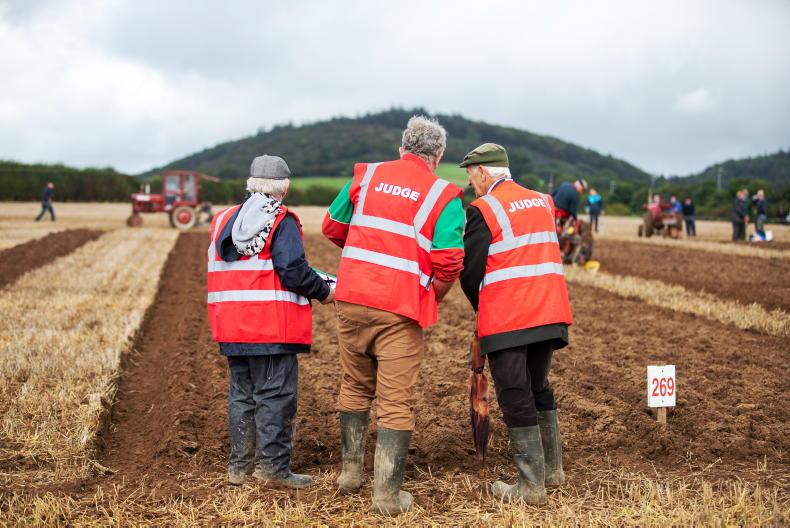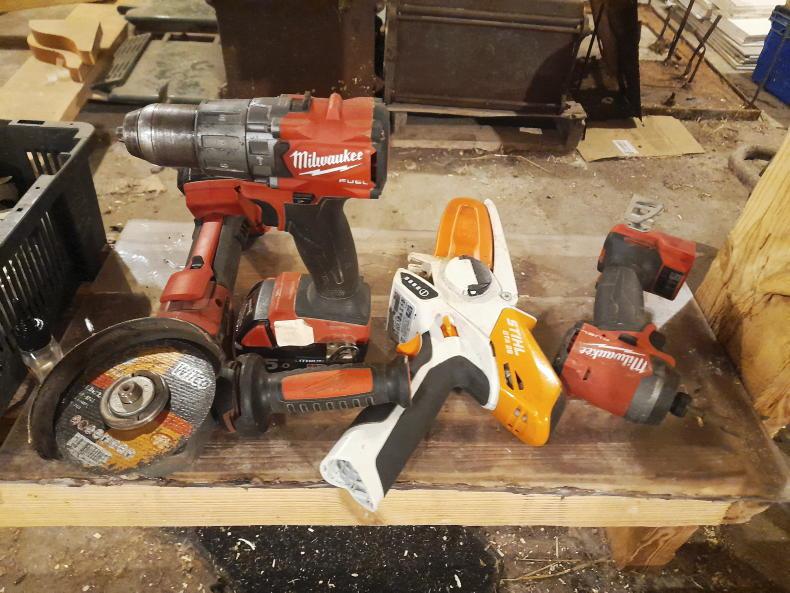They say that a dentist doesn’t notice you, he notices your teeth. Well, it’s the same with behavioural psychotherapists like myself. I don’t notice people; I notice their behaviour.
So it was that I observed the two elderly men standing on a windswept hill when I attended my first Ploughing Championship in 2018.
It was their calmness and detachment that caught my eye. A quiet concentration in their manner that I could see from a distance, such that I couldn’t help but be drawn up the hill to where some hardy souls were watching the ploughing competition.
Of course, as a “Dulchie” (A Dubliner, now living in culchie land), I knew nothing about ploughing outside it being a fancy way of digging a hole and about as much fun to watch as a dripping tap.
Standing there, like a pig looking into a spaceship, I found myself watching the people as they watched the ploughing. And it was this that really caught my attention. Each of them had the same quiet calmness about them that is very rare to see in busy city life.
The hustle and bustle of the event down the hill was just background noise to them. Here it was like stepping into a church from a busy city street: urgency to calmness in a few steps.
I got chatting to the two elderly farmers that I had noticed from down the hill. With a natural warmth and acceptance, they patiently let me into the captivating world of the plough.
As the driver started his row, his whole focus was on controlling the plough, adjusting his speed to ensure that the coulter didn’t move away from the furrow wall. Sometimes the coulter would press hard against the wall as the plough tried to cut a wider furrow, so that steering a plough was like steering a boat.
As I slowed my life to the pace of the plough, I became fascinated at the technique. By stopping and looking I could see so much more. Far from being boring, I could see how much skill was involved.
All the people were concentrating enormously. The “in-the-moment” movement of the plough as it cut the furrow captivated me most. Everyone’s focus was on the next turn of the sod. Everything in the world outside of that was just that, outside.
In that shared moment with the two lads, I completely lost track of time, finding a peace in that moment that brought me back to when I was a child sitting beside my granny as she quietly recited the decades of the Rosary.
As she nimbly passed each bead between her gnarly fingers, she also found that same calm world as the two men. By focusing on the rhythm of each decade, she left the past and future outside.
Sitting beside her, I could share the peace she found in the present moment. Standing beside the two lads on that hill, I found the same peace. Indeed, go into any mart in the country, and you will find people quietly sitting there. Finding the same peace in the rhythmic ritual of the animals passing through.
As the afternoon slowly drifted into evening, my mind was dragged back to the hustle down the hill and the world that I knew I’d eventually have to return to.
As I thanked the two lads for allowing me to share their world, I remarked that it was time for me to go back to the real world. Quietly, one of them looked around him saying back to me: “Maybe this is the real world.”

\ Claire Nash
A few years ago, a retired hospice nurse wrote a book about how we all share the same regrets just before we die. Chief among these was the wish that “I hadn’t worked so hard”.
Life is a journey, not a destination. Whether it is ploughing a field or saying the rosary both help us find peace in the moment. They help us stop and focus on the journey.
Both are forms of meditation and involve focusing on the present moment. Detaching from our prejudices, dismissing our thoughts and feelings, thereby soothing our mind.
Mindfulness is not a new fad. It’s been practiced in every society for thousands of years. Similarly, meditation doesn’t mean having to sit still. Any rhythmic activity that results in us detaching ourselves from our thoughts and feelings can be regarded as meditation. Many people find this through jogging, driving, walking or like me, mowing the lawn.
Did you know that most of what you’ve ever felt anxious about has never come true? Fear is about something that has already happened, and we are afraid it will happen again.
Anxiety is about something that hasn’t happened yet. As a result, our brain overreacts looking for potential dangers. The deeper it searches, the more potential dangers it sees which are never correct. Anxiety is the interest we pay on a non-existent loan. By doing things that help us get out of our thinking, we are able to see what’s happening in front of us.
Our brains, by focusing on the real world in front of our eyes, is able to see that there is no actual danger in front of us just the potential threats in our head.
When we focus on the future, we get anxious. When we focus on the past, we get depressed. When we focus on the present, we relieve both.
Drive yourself calm, not crazy

\ Claire Nash
Like everything in life, the more we practice something, the better we get at it. You probably haven’t realised this but you’ve being practicing mindfulness techniques all your life.
Look around you at times that you haven’t felt anxious. These are the times that your brain is focused on what’s actually happening in front of you, rather than what’s happening in your head.
At these times you have probably being involved in some form of simple rhythmic activity, like standing beside the ring at the mart, cutting silage, baking bread or cleaning the house.
Look out for these activities in your daily life that you find soothing and use them to switch of the washing machine in your head.
Frequently pause and take three long breaths. Remind yourself of what you are doing and why you are doing it.
When you find you mind drifting away, make an effort to bring yourself back to the matter in hand. These simple practices will breathe space into your daily routines, bringing your peace to a whole new level.
Mindfulness isn’t just about practicing exercises but learning to live mindfully. So, learn from the experts. Watch the contractors as they rythmically plough or harvest. People saying the rosary or doing the stations in Lough Derg.
Ninety-five per cent of our behaviour runs on autopilot which usually ends up with us stressed. By intentionally taking control of our auto pilot, we can guide our actions and slow our thinking into peaceful co-existence with reality.
Mindfulness slows the brain. The more we activate our slow brain, the stronger it gets. Every time we focus our brain on our daily activities, we stimulate our brains into seeing the present. Which is where peace is to be found.
Enda Murphy is a cognitive behavioural therapist who focuses on supporting adults to support young people. For more details go to seeme.ie
Read more
The sinister side of athleticism
Learning to cope with health anxiety
They say that a dentist doesn’t notice you, he notices your teeth. Well, it’s the same with behavioural psychotherapists like myself. I don’t notice people; I notice their behaviour.
So it was that I observed the two elderly men standing on a windswept hill when I attended my first Ploughing Championship in 2018.
It was their calmness and detachment that caught my eye. A quiet concentration in their manner that I could see from a distance, such that I couldn’t help but be drawn up the hill to where some hardy souls were watching the ploughing competition.
Of course, as a “Dulchie” (A Dubliner, now living in culchie land), I knew nothing about ploughing outside it being a fancy way of digging a hole and about as much fun to watch as a dripping tap.
Standing there, like a pig looking into a spaceship, I found myself watching the people as they watched the ploughing. And it was this that really caught my attention. Each of them had the same quiet calmness about them that is very rare to see in busy city life.
The hustle and bustle of the event down the hill was just background noise to them. Here it was like stepping into a church from a busy city street: urgency to calmness in a few steps.
I got chatting to the two elderly farmers that I had noticed from down the hill. With a natural warmth and acceptance, they patiently let me into the captivating world of the plough.
As the driver started his row, his whole focus was on controlling the plough, adjusting his speed to ensure that the coulter didn’t move away from the furrow wall. Sometimes the coulter would press hard against the wall as the plough tried to cut a wider furrow, so that steering a plough was like steering a boat.
As I slowed my life to the pace of the plough, I became fascinated at the technique. By stopping and looking I could see so much more. Far from being boring, I could see how much skill was involved.
All the people were concentrating enormously. The “in-the-moment” movement of the plough as it cut the furrow captivated me most. Everyone’s focus was on the next turn of the sod. Everything in the world outside of that was just that, outside.
In that shared moment with the two lads, I completely lost track of time, finding a peace in that moment that brought me back to when I was a child sitting beside my granny as she quietly recited the decades of the Rosary.
As she nimbly passed each bead between her gnarly fingers, she also found that same calm world as the two men. By focusing on the rhythm of each decade, she left the past and future outside.
Sitting beside her, I could share the peace she found in the present moment. Standing beside the two lads on that hill, I found the same peace. Indeed, go into any mart in the country, and you will find people quietly sitting there. Finding the same peace in the rhythmic ritual of the animals passing through.
As the afternoon slowly drifted into evening, my mind was dragged back to the hustle down the hill and the world that I knew I’d eventually have to return to.
As I thanked the two lads for allowing me to share their world, I remarked that it was time for me to go back to the real world. Quietly, one of them looked around him saying back to me: “Maybe this is the real world.”

\ Claire Nash
A few years ago, a retired hospice nurse wrote a book about how we all share the same regrets just before we die. Chief among these was the wish that “I hadn’t worked so hard”.
Life is a journey, not a destination. Whether it is ploughing a field or saying the rosary both help us find peace in the moment. They help us stop and focus on the journey.
Both are forms of meditation and involve focusing on the present moment. Detaching from our prejudices, dismissing our thoughts and feelings, thereby soothing our mind.
Mindfulness is not a new fad. It’s been practiced in every society for thousands of years. Similarly, meditation doesn’t mean having to sit still. Any rhythmic activity that results in us detaching ourselves from our thoughts and feelings can be regarded as meditation. Many people find this through jogging, driving, walking or like me, mowing the lawn.
Did you know that most of what you’ve ever felt anxious about has never come true? Fear is about something that has already happened, and we are afraid it will happen again.
Anxiety is about something that hasn’t happened yet. As a result, our brain overreacts looking for potential dangers. The deeper it searches, the more potential dangers it sees which are never correct. Anxiety is the interest we pay on a non-existent loan. By doing things that help us get out of our thinking, we are able to see what’s happening in front of us.
Our brains, by focusing on the real world in front of our eyes, is able to see that there is no actual danger in front of us just the potential threats in our head.
When we focus on the future, we get anxious. When we focus on the past, we get depressed. When we focus on the present, we relieve both.
Drive yourself calm, not crazy

\ Claire Nash
Like everything in life, the more we practice something, the better we get at it. You probably haven’t realised this but you’ve being practicing mindfulness techniques all your life.
Look around you at times that you haven’t felt anxious. These are the times that your brain is focused on what’s actually happening in front of you, rather than what’s happening in your head.
At these times you have probably being involved in some form of simple rhythmic activity, like standing beside the ring at the mart, cutting silage, baking bread or cleaning the house.
Look out for these activities in your daily life that you find soothing and use them to switch of the washing machine in your head.
Frequently pause and take three long breaths. Remind yourself of what you are doing and why you are doing it.
When you find you mind drifting away, make an effort to bring yourself back to the matter in hand. These simple practices will breathe space into your daily routines, bringing your peace to a whole new level.
Mindfulness isn’t just about practicing exercises but learning to live mindfully. So, learn from the experts. Watch the contractors as they rythmically plough or harvest. People saying the rosary or doing the stations in Lough Derg.
Ninety-five per cent of our behaviour runs on autopilot which usually ends up with us stressed. By intentionally taking control of our auto pilot, we can guide our actions and slow our thinking into peaceful co-existence with reality.
Mindfulness slows the brain. The more we activate our slow brain, the stronger it gets. Every time we focus our brain on our daily activities, we stimulate our brains into seeing the present. Which is where peace is to be found.
Enda Murphy is a cognitive behavioural therapist who focuses on supporting adults to support young people. For more details go to seeme.ie
Read more
The sinister side of athleticism
Learning to cope with health anxiety











SHARING OPTIONS